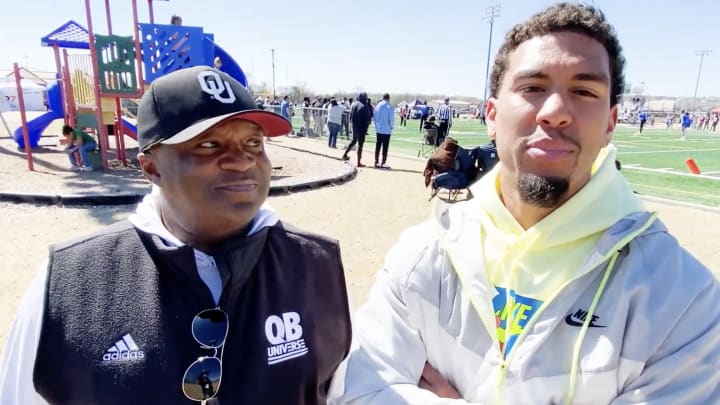Oklahoma QBs Charles and Casey Thompson Giving Back as Youth Coaches

BROKEN ARROW, OK — New take on an old joke: how many Oklahoma quarterbacks does it take to coach a 7-on-7 football team?
Right now, it takes two.
That’s no punchline.
Long time youth coach Charles Thompson and his son Casey spent the offseason coaching Hustle Inc. 405’s elite 7-on-7 squad, and of course it was a fulfilling family experience.
“God does things for a reason. God has the timing and place of things,” Charles said. “Casey, obviously the injuries are unfortunate. But this opportunity we’re sharing as father and son, it’s a blessing. That’s how we view it.”
And you’d better believe the kids are getting the full gamut of offensive football from a couple of Oklahoma high school football legends.
“Different style of quarterbacks, huh?” Charles said.
Just a little.
Charles was an electrifying option quarterback coming out of Lawton and became Barry Switzer’s last great wishbone wizard before infamously running afoul of the law as an OU sophomore.
Casey was a dual-threat master of the spread at Southmoore and Newcastle, amassing 13,078 yards (9,829 passing, 3,249 rushing) and 154 touchdowns (107 and 47) before heading off to college.
Both have been around the block on the college scene: Charles ended up winning an NAIA national championship as a running back at Central State (OH) following his exile from OU, and Casey studied the game at Texas, Nebraska and Florida Atlantic before transferring to his dream school for his seventh and final season.
Now Casey is a Sooner backup to Jackson Arnold. He’s still powering up after his knee injury last year in Boca Raton, but he is expected to be full speed when the team reconvenes in August for 2024 training camp.
And getting to coach a little on the side is only expanding his football knowledge.
“We look at it (as) Casey’s learning,” Charles told Sooners on SI after a recent tournament. “I’m trying to instill in him at this young age what it’s like for him to be going through this experience. So that’s what we’re doing.”
In addition to learning Seth Littrell’s playbook at OU while also integrating himself into the team as its oldest player while also rehabbing his knee, Casey decided during the spring that he had more to give.
“It’s just all about time management, making it a priority,” Casey told Sooners on SI. “We all have 24 hours in a day, seven days in a week. It’s all about how you spend your time and what you do with it. I love football. I love the game and what it’s done for me, and I always want to give back. If I can take a couple days a week or a few hours on a Monday or Tuesday or Thursday night, and I have the free time to do it, then I’ll definitely put it back into these kids and try to have an impact on them, as much as I can.
“But yeah, just long work days from my own practices and team meetings and my own workouts and stuff like that, and treatment. Sometimes during the week I can’t make it to all the meetings, and so my dad will take over. But on the weekends, for the most part, I’ve been blessed and fortunate enough to have a few days off over the weekends, and so I spend my weekends helping out the kids.”
Charles is the head coach. Casey is the offensive coordinator. The spring and summer 7-on-7 scene is laid back by nature: no tackling, almost zero contact (that’s the rule, anyway), all passing. It’s touch football. But it instills in the athletes an inherent understanding of spacing and timing, two things that easily carry over into contemporary football schemes.
WATCH ON YOUTUBE
Charles said he’s been coaching youth for about 25 years now, and stepped into 7-on-7 a few years ago when it began to explode in popularity.
“I remember coming into this tournament (in Broken Arrow) a couple years ago, and I was having trouble getting the kids to understand the system,” Charles said. “I called Casey on the phone. At the time he was at the University of Texas. I said, ‘I need an offense.’ So he started installing our offense and we started running a lot of Texas’ stuff and that concept, and that’s what we’re doing now.
“But he’s here, and being part of the University of Oklahoma football team, he’s able to help me coach. So this is what we’ve kind of gone to now.”
Being Charles or Casey Thompson and coaching high school-age kids in Oklahoma comes with a certain gravitas, a credibility that can’t be faked.
“I would say it’s moreso about the fact that they know we know what we’re talking about,” Casey said. “They know the system and the plays and the technique we’re teaching, the reads we’re installing, the work ethic we’re putting in. They know it’s coming from a place of expertise. It’s not coming from us. This is just stuff we’re passing down. He’s learned it from Barry Switzer and teams that he’s played on, and I’ve learned this stuff from a lot of the coaches I’ve had over the years. And quite honestly, from every place I’ve been, every team I’ve been on, I’ve learned different things that I could pass down and pass on.
“I’ve learned a lot from him as well, just what it looks like to make the right reads and do the right thing and be on time and execute on the field and off the field. We’re just trying to pass along things that we were taught early on playing football. Now that we’re coaches, I think it’s good for us to install that to kids.”
Although the 7-on-7 vibe can be very laid back, the intensity has a tendency to quickly escalate. Everyone wants a college scholarship, and egos can sometimes exceed abilities. Taunting is discouraged, but trash talk and over-the-top celebrations are common.
And the Thompsons can match that intensity. Coaching from the sideline is precise and can be businesslike, but when the team was eliminated early from last spring’s event in Broken Arrow, Charles lit into them for a good 10 minutes, followed by 10 more minutes from the defensive coordinator and almost 15 minutes from Casey, the offensive coordinator.
Coaches felt the team’s standards were not met, and they were not shy about letting the players know.
“It’s really not about the 7-on-7. It’s about the process,” Charles said. “So we do have meetings, we do have things that we have as a standard so the kids can understand it. And we have expectations in terms of how we have to execute.
“We do a good job of instilling our offense, so when they get here, there’s already film and Zooms and practices, so we know, ‘Here’s the spacing, here’s the footwork, here’s the eyes.’ Because that’s what it’s gonna take to get to the next level, whether it’s high school, some on to college, and then some will have the opportunity to go even above that. It’s about being committed to that process.”
